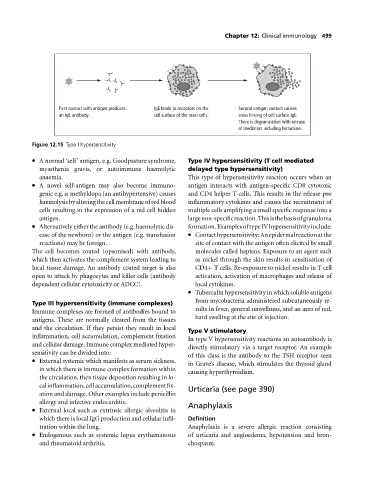Page 503 - Medicine and Surgery
P. 503
P1: KOA
BLUK007-12 BLUK007-Kendall May 12, 2005 20:37 Char Count= 0
Chapter 12: Clinical immunology 499
First contact with antigen produces IgE binds to receptors on the Second antigen contact causes
an IgE antibody. cell surface of the mast cells. cross linking of cell surface IgE.
There is degranulation with release
of mediators including histamine.
Figure 12.15 Type I hypersensitivity.
Anormal ‘self’ antigen, e.g. Goodpasture syndrome, Type IV hypersensitivity (T cell mediated
myasthenia gravis, or autoimmune haemolytic delayed type hypersensitivity)
anaemia. This type of hypersensitivity reaction occurs when an
Anovel self-antigen may also become immuno- antigen interacts with antigen-specific CD8 cytotoxic
genic e.g. α methyldopa (an antihypertensive) causes and CD4 helper T-cells. This results in the release pro
haemolysisbyalteringthecellmembraneofredblood inflammatory cytokines and causes the recruitment of
cellsresulting in the expression of a red cell hidden multiple cells amplifying a small specific response into a
antigen. largenon-specificreaction.Thisisthebasisofgranuloma
Alternatively either the antibody (e.g. haemolytic dis- formation.ExamplesoftypeIVhypersensitivityinclude:
ease of the newborn) or the antigen (e.g. transfusion Contacthypersensitivity:Anepidermalreactionatthe
reactions) may be foreign. site of contact with the antigen often elicited by small
The cell becomes coated (opsonised) with antibody, molecules called haptens. Exposure to an agent such
which then activates the complement system leading to as nickel through the skin results in sensitisation of
local tissue damage. An antibody coated target is also CD4+ Tcells. Re-exposure to nickel results in T cell
open to attack by phagocytes and killer cells (antibody activation, activation of macrophages and release of
dependent cellular cytotoxicity or ADCC). local cytokines.
Tuberculin hypersensitivity in which soluble antigens
from mycobacteria administered subcutaneously re-
Type III hypersensitivity (immune complexes)
Immune complexes are formed of antibodies bound to sults in fever, general unwellness, and an area of red,
antigens. These are normally cleared from the tissues hard swelling at the site of injection.
and the circulation. If they persist they result in local
Type V stimulatory
inflammation, cell accumulation, complement fixation
In type V hypersensitivity reactions an autoantibody is
and cellular damage. Immune complex mediated hyper-
directly stimulatory via a target receptor. An example
sensitivity can be divided into:
of this class is the antibody to the TSH receptor seen
External systemic which manifests as serum sickness,
in Grave’s disease, which stimulates the thyroid gland
in which there is immune complex formation within
causing hyperthyroidism.
the circulation, then tissue deposition resulting in lo-
calinflammation,cellaccumulation,complementfix- Urticaria (see page 390)
ation and damage. Other examples include penicillin
allergy and infective endocarditis. Anaphylaxis
External local such as extrinsic allergic alveolitis in
which there is local IgG production and cellular infil- Definition
tration within the lung. Anaphylaxis is a severe allergic reaction consisting
Endogenous such as systemic lupus erythematosus of urticaria and angioedema, hypotension and bron-
and rheumatoid arthritis. chospasm.

